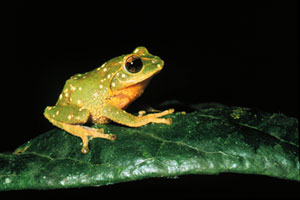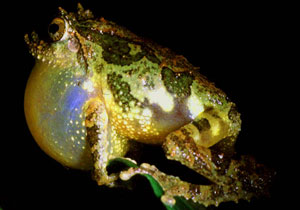 |
|
||
|
|||
Island
hoppers
Sri Lankan tree frogs end game of hide-and-seek
By Tim Stoddard
High above Sri Lanka’s sprawling tea plantations in the island’s last scraps of rain forest, a team of biologists has made an unlikely discovery: a family of over 100 new species of tree frogs previously unknown to science. The researchers, led by Christopher Schneider, a CAS assistant professor of biology, and his doctoral student Madhava Meegaskumbura (GRS’07), say that the finding makes Sri Lanka an amphibian hotspot of global significance.
|
|
|
| Most of the newly discovered tree frogs undergo direct terrestrial development, bypassing the aquatic tadpole stage and developing as fully formed froglets within the egg. Photos by Madhava Meegaskumbura |
|
While biologists are describing new amphibian species all the time, the
discovery of a large group of closely related frogs is a rare event, particularly
in a country as developed as Sri Lanka. “It’s certainly not
unusual to find new frog species,” says Karen Warkentin, a CAS assistant
professor of biology, who studies amphibians in the neotropics. “But
finding so many in what was thought to be a reasonably well-studied place
is noteworthy.”
The Sri Lankan frogs are a prime example of the vast diversity that has
yet to be described in the tropics, says James Hanken, curator in herpetology
and director of the Museum of Comparative Zoology at Harvard University.
“This finding reinforces what a number of us have been trying to
announce for years,” he says, “which is that there are still
many, many undescribed species of amphibians worldwide. That idea catches
a lot of people by surprise, because it’s generally assumed that
all vertebrate species are known.”
There are currently about 5,400 amphibian species known to science, and
while the rate of frog discovery is increasing, Hanken says, many biologists
were surprised by the finding in Sri Lanka. Over 95 percent of the island’s
forests have been cleared for coffee and tea plantations, and until now,
it was thought that the island’s flora and fauna had been exhaustively
cataloged. “The British were running all over Sri Lanka for 150
years,” he says, “and they were good naturalists. I think
they probably just couldn’t be bothered to describe these little
frogs.”
The frogs, which range from husky canopy dwellers with oversized toe pads for climbing to tiny orange denizens of the leaf litter, are a stunning example of adaptive radiation, Schneider says. They look and behave very differently, but their DNA reveals that they’ve recently evolved from a common ancestor, adapting new body shapes to exploit a range of ecological niches.
|
|
|
| This lowland species is most abundant near home gardens with good ground cover. It has yet to be officially described, but because of its preference for human landscapes, its working name is Hiniduma anthropogenic. | |
In their report, which appeared in the October 11 issue of Science, the
authors suggest that Sri Lanka should be designated an amphibian hotspot.
The term hotspot, first made popular by the nonprofit group Conservation
International, would attract much-needed attention to Sri Lanka’s
frogs, says Meegaskumbura. While it would not carry any legal power, hotspot
designation would encourage conservation groups to focus their efforts
there rather than in less diverse regions.
At least 270 species of vertebrates have been recorded on Sri Lanka, but
until now biologists had documented only 18 frog species. Schneider’s
group estimates that it has found over 100 new species of frogs, but it
will be several months before they settle on a definitive number.
Almost all of the newly discovered frogs have evolved a trait called direct
terrestrial development. Instead of laying eggs that hatch as tadpoles,
direct developers bypass the aquatic life stage altogether. Fully formed
froglets, which look like miniature adults, hop out of their shells from
day one. At a time when scientists are reporting alarming amphibian declines
worldwide, the Sri Lankan frogs suggest that direct development might
be a safer way to live. Frogs are extremely sensitive to environmental
stresses, Schneider says, because most of them have both aquatic and terrestrial
life stages. Tadpoles are vulnerable to pollutants and ultraviolet radiation,
so direct development might shield frogs from those stresses.
But other researchers are more pessimistic about the fate of direct-developing
species. “By no means is direct development a magic bullet that
protects frogs from decline,” Hanken says. “There are a dozen
species of frogs endemic to Puerto Rico; they’re all direct-developing,
and at least two or three species are now extinct.”
|
|
|
| First described by British naturalists in the late 1700s as Theloderma schmarda, this reclusive frog is in need of a new name. Molecular analysis of its DNA has revealed that it’s not in the genus Theloderma at all, but has evolved traits resembling that group. |
|
The Sri Lankan frog survey began in 1993, when Meegaskumbura and four
other Sri Lankan researchers from the World Heritage Trust (WHT) began
to look carefully at the frogs in highland forests. “The WHT is
pretty good with its taxonomy,” Meegaskumbura says, “but we
were unsure about the genetic relationships between the frogs. All we
knew was that there was a lot of diversity.”
Hoping to sort out the frog lineages, and earn a Ph.D. in the process,
Meegaskumbura e-mailed Schneider to inquire about becoming a doctoral
student in his lab. With Schneider’s help, he proposed to discern
the relationships between these previously undescribed tree frogs. “The
project fit in so well with my overall research goals of understanding
diversification in the tropics,” says Schneider, whose earlier work
with Australian skinks is shedding light on how new species form. “And
here was this incredible student who knew so much about these frogs already.
There was no way that I was going to pass it up.”
In 1999, Schneider’s group met in Sri Lanka and caught frogs for
three weeks in the island’s southwestern mountains. During the five
years prior to that expedition, the WHT workers had already cataloged
and curated frogs from over 500 sites in the forest, Schneider says, and
the bulk of the work was already complete by the time he arrived. The
WHT has recently started a captive breeding program for several of the
endangered tree frogs. Meegaskumbura hopes to return to Sri Lanka in the
summer of 2003 to continue developing that program. The frogs also fit
into his long-range career goals. “I’m hoping to work on this
radiation of frogs for the rest of my life,” he says.
While many amphibian populations continue to decline, Schneider is hopeful
about what new species await discovery in other tropical forests. “If
you can turn up 120 species of frogs in a tiny piece of Sri Lanka that’s
lost 95 percent of its rain-forest cover, what does that tell you about
big, intact areas?” he asks. “Imagine what we’re going
to discover in New Guinea. The point is that tropical regions worldwide
are still not very well explored.”
![]()
18 October 2002
Boston University
Office of University Relations


